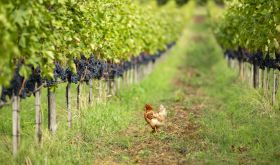Alex Gambal of Maison Alex Gambal writes the following report on the fortunes and misfortunes of Burgundy in 2013.
As I write these notes on a beautiful Indian Summer day I ask myself a question many ask me about my profession: romance or stress, stress or romance, a bit of both or more of the other? For the second year in a row, stress won. We were challenged by a late and poor flowering, hail in July, mixed weather in September and a late October harvest not seen since 1978.
This said, it is years such as this, as well as 2012, that demonstrate who has the talent in the vines and in the cuveries to produce the best wines. Here are the salient points that have 'made the year' and how we managed these challenges. (For the record, I have gone back to my journal in order to give you my direct impressions.)
Winter 2013: We never had a very cold stretch but we had rain on and off for the months of January, February and March. The water table was saturated. There was no fear of drought conditions for the summer.
April: A cold wet April delayed the budbreak with days at the end of April overcast, raining, and cold. On 27 April it was 36 ºF [2.2 ºC] at my home in in the Hautes-Côtes at 9.30 am with wet snow on the cliffs!
May: Some of you heard that May was one of the wettest on record for the Côte d'Or. Driving rain fell over the Burgundy region with steady downpours on the night of Friday 5 May. You also might remember the photos of Savigny flooded almost up the route national and water in our cellar up to about eight inches.
As I re-read my notes I am amazed by what I wrote; each day rain, on and off, cool to cold. Many mornings in the 50s. I left my home at 6 am on 24 May for the Revue du Vin de la France tasting in Paris and it was again 36 ºF! In Paris other winemakers in Bandol told me of the same cold weather.
June: The weather was marginally better with a string of 14 lovely days at the beginning of the month followed by cooler, unstable weather. The upshot is that flowering occurs under difficult conditions in mid to late June having already lost buds to the cold wet May. The month ends with wet cool weather, often foggy with one day noted as 'a November day'.
July: Not bad but the prevailing weather patterns remain; humidity from either the south west or south. We have not had an extended high-pressure system at all this year. Weather patterns are a funny (not ha-ha) statistical phenomena that once in motion seem to stay in what seems a perpetual motion machine.
As I look back at my notes, I see high temperatures and humidity in the third week; a formula for trouble that arrived as hail on 23 July after several days in the 90s. As most of you know, the vineyards from Meursault to Pernand-Vergelesses/Corton-Charlemagne suffered great damage: up to 50-100% (following 2012's hail damage of 70-90% in Volnay and Pommard).
You have heard us say many times that storms in Burgundy are 'local'. I believe the following measures of rainfall from 23 to 24 July will relay to you the capriciousness of these storms, their violent nature, and the sheer luck of who gets damaged and who is hardly touched.
Please remember how close these villages are to one another and especially the proximity of Volnay and Monthelie. The fact that Volnay received more than six times as much rain is astounding!
St-Romain: 11.6 mm / .45 inch
Meursault: 18.2 mm / .72 inch
Monthelie: 9.4 mm / .35 inch
Volnay: 57 mm / 2.25 inches
Pommard: 44 mm / 1.73 inches
Beaune: 45.6 mm / 1.80 inches
Savigny-lès-Beaune: 52.2 mm / 2.06 inches
Pernand-Vergelesses: 41.4 mm / 1.62 inches
Ladoix: 23.8 mm / .94 inch
August: A hot humid month, we continue to treat for [downy] mildew and oidium [powdery mildew], but we have a lovely mid-month stretch of dry weather. The pressure from fungal diseases of the vines and grapes does not abate as I return from vacation on 26 August to find my pumpkin plants ravaged by oidium.
September: Harvest is projected at the end of the month: 30 September or perhaps a bit earlier if we get a good hot dry stretch. A few warmish days and then cool weather arrives. 11 September is 48 ºF [8.9 ºC] and the first fire of the season in my wood stove.
We begin to take the first prélèvements [samples] for the year's harvest. Some parcels lovely, ripening correctly, others ripening very slowly due to the hail damage. In any case, yields are not going to be extraordinary due to the aforementioned conditions, along with thick skins and little juice.
We have several lovely days but the days are getting shorter, the weather cooler; fall is in the air; we will begin on Monday 30 September.
October: Well, there you have it. We picked over an 11-day period, the wines are now fermenting nicely and if there were a few rules here they are:
- Even more so than normal, each parcel had to be evaluated and harvested based on its health, sugars, acids, and its ability to either get riper (or not).
- Triage in the vines was primordial, as it was in the cuverie.
- Hail-damaged grapes were less of a problem because the dried berries were removed via our vibrating sorting table.
- Wines in the Côte de Nuits were not affected by the hail but yields are again low due to the poor flowering.
- Our reds are showing good clean ripe fruit and often exotic perfumes; always a good omen.
- Our whites have good balance and the sugars were surprisingly high.
- Overall yields between 2001 and 2012 levels; that is to say, again very low.
New wines: From the (somewhat controlled) chaos of the harvest, opportunities arose to make wines from interesting parcels and terroirs. New this year are a St-Romain blanc from wonderful old vines, a Vougeot village wine from the monopole of the Clos du Château (just two pièces, 600 bottles from wonderful grapes), two pièces of Gevrey-Chambertin from the Clos du Justice, and for some real fun an Aligoté.













